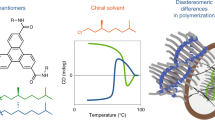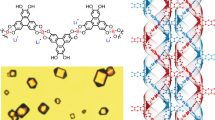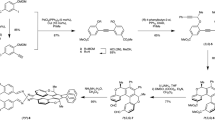Abstract
Homochiral or enantioenriched helical polymers are essential for investigating the relationship between chirality of helical structures and their performance in the design of various optically active functional polymers. We have succeeded in obtaining the helical poly(phenylacetylene)s poly(1)–poly(6) possessing no chiral moieties, except for helicity; the enantioenriched helical sense of these polymers was induced by transformation in chiral solvents, followed by removal of the chiral solvents, even if the interaction between the chiral molecule and the polymer was weak such as solvent–solute interaction. In particular, the newly synthesized poly(6) retained the induced helical sense even in an achiral solvent.
Similar content being viewed by others
Log in or create a free account to read this content
Gain free access to this article, as well as selected content from this journal and more on nature.com
or
References
Aoki, T., Kaneko, T. & Teraguchi, M. Synthesis of functional π-conjugated polymers from aromatic acetylenes. Polymer 47, 4867–4892 (2006).
Akagi, K. Helical polyacetylene: asymmetric polymerization in a chiral liquid-crystal field. Chem. Rev. 109, 5354–5401 (2009).
Yashima, E., Maeda, K., Iida, H., Furusho, Y. & Nagai, K. Helical polymers: synthesis, structures, and functions. Chem. Rev. 109, 6102–6211 (2009).
Liu, J., Lam, J. W. Y. & Tang, B. Z. Acetylenic polymers: syntheses, structures, and functions. Chem. Rev. 109, 5799–5867 (2009).
Nolte, R. J. M., van Beijnen, A. J. M., & Drenth, W. Chirality in polyisocyanides. J. Am. Chem. Soc. 96, 5932–5933 (1974).
Okamoto, Y., Suzuki, K., Ohta, K., Hatada, K. & Yuki, H. Optically active poly(triphenylmethyl methacrylate) with one-handed helical conformation. J. Am. Chem. Soc. 101, 4763–4765 (1979).
Kamer, P. C. J., Nolte, R. J. M. & Drenth, W. Screw sense selective polymerization of achiral isocyanides catalyzed by optically active nickel(II) complexes. J. Am. Chem. Soc. 110, 6818–6825 (1988).
Deming, T. J. & Novak, B. M. Enantioselective polymerizations of achiral isocyanides. Preparation of optically active helical polymers using chiral nickel catalysts. J. Am. Chem. Soc. 114, 7926–7927 (1992).
Ito, Y., Ohara, T., Shima, R. & Suginome, M. Highly screw-sense selective polymerization of 1,2-diisocyano-3,6-di-p-tolylbenzene initiated by optically active binaphthylpalladium(II) complexes. J. Am. Chem. Soc. 118, 9188–9189 (1996).
Habaue, S., Seko, T. & Okamoto, Y. Copper(I)-catalyzed asymmetric oxidative coupling polymerization of 2,3-dihydroxynaphthalene using bisoxazoline ligands. Macromolecules 36, 2604–2608 (2003).
Tian, G., Lu, Y. & Novak, B. M. Helix-sense selective polymerization of carbodiimides: building permanently optically active polymers from achiral monomers. J. Am. Chem. Soc. 126, 4082–4083 (2004).
Akagi, K., Piao, G., Kaneko, S., Sakamaki, K., Shirakawa, H. & Kyotani, M. Helical polyacetylene synthesized with a chiral nematic reaction field. Science 282, 1683–1686 (1998).
Goto, H. & Akagi, K. Optically active conjugated polymers prepared from achiral monomers by polycondensation in a chiral nematic solvent. Angew. Chem. Int. Ed. Engl. 44, 4322–4328 (2005).
Holder, S. J., Achilleos, M. & Jones, R. G. Increasing molecular weight parameters of a helical polymer through polymerization in a chiral solvent. J. Am. Chem. Soc. 128, 12418–12419 (2006).
Aoki, T., Kaneko, T., Maruyama, N., Sumi, A., Takahashi, M., Sato, T. & Teraguchi, M. Helix-sense-selective polymerization of phenylacetylene having two hydroxy groups using a chiral catalytic system. J. Am. Chem. Soc. 125, 6346–6347 (2003).
Sato, T., Aoki, T., Teraguchi, M., Kaneko, T. & Kim, S.- Y. Role of chiral amine cocatalysts in the helix-sense-selective polymerization of a phenylacetylene using a catalytic system. Polymer 45, 8109–8114 (2004).
Umeda, Y., Kaneko, T., Teraguchi, M. & Aoki, T. Helix-sense-selective polymerization of a phenylacetylene bearing an achiral and bulky galvinoxyl moiety. Chem. Lett. 34, 854–855 (2005).
Kaneko, T., Umeda, Y., Yamamoto, T., Teraguchi, M. & Aoki, T. Assignment of helical sense for poly(phenylacetylene) bearing achiral galvinoxyl chromophore synthesized by helix-sense-selective polymerization. Macromolecules 38, 9420–9426 (2005).
Teraguchi, M., Mottate, K., Kim, S.- Y., Aoki, T., Kaneko, T., Hadano, S. & Masuda, T. Synthesis of chiral helical poly(hydroxyl-containing phenylacetylene) membranes by in-situ depinanylsilylation and their enantioselective permeabilities. Macromolecules 38, 6367–6373 (2005).
Yashima, E., Matsushima, T. & Okamoto, Y. Poly((4-carboxyphenyl)acetylene) as a probe for chirality assignment of amines by circular dichroism. J. Am. Chem. Soc. 117, 11596–11597 (1995).
Majidi, M. R., Kane-Maguire, L. A. P., & Wallace, G. G. Chemical generation of optically active polyaniline via the doping of emeraldine base with (+)- or (−)-camphorsulfonic acid. Polymer 36, 3597–3599 (1995).
Schlitzer, D. S. & Novak, B. M. Trapped kinetic states, chiral amplification and molecular chaperoning in synthetic polymers: chiral induction in polyguanidines through ion pair interactions. J. Am. Chem. Soc. 120, 2196–2197 (1998).
Maeda, K., Yamamoto, N. & Okamoto, Y. Helicity induction of poly(3-carboxyphenyl isocyanate) by chiral acid-base interaction. Macromolecules 31, 5924–5926 (1998).
Yashima, E., Maeda, K. & Yamanaka, T. Helicity induction and conformational dynamics of poly(bis(4-carboxyphenoxy)phosphazene) with optically active amines. J. Am. Chem. Soc. 122, 7813–7814 (2000).
Ishikawa, M., Maeda, K. & Yashima, E. Macromolecular chirality induction on optically inactive poly(4-carboxyphenyl isocyanide) with chiral amines: a dynamic conformational transition of poly(phenyl isocyanide) derivatives. J. Am. Chem. Soc. 124, 7448–7458 (2002).
Prince, R. B., Barnes, S. A. & Moore, J. S. Foldamer-based molecular recognition. J. Am. Chem. Soc. 122, 2758–2762 (2000).
Tanatani, A., Mio, M. J. & Moore, J. S. Chain length-dependent affinity of helical foldamers for a rodlike guest. J. Am. Chem. Soc. 123, 1792–1793 (2001).
Nonokawa, R. & Yashima, E. Helicity induction on a poly(phenylacetylene) derivative bearing aza-18-crown-6 ether pendants in water. J. Polym. Sci. Polym. Chem. Ed. 41, 1004–1013 (2003).
Sakai, R., Satoh, T., Kakuchi, R., Kaga, H. & Kakuchi, T. Macromolecular helicity induction for novel optically inactive poly(phenyl isocyanate) bearing crown ether based on the host-guest complexation. Macromolecules 36, 3709–3713 (2003).
Abe, H., Masuda, N., Waki, M. & Inouye, M. Regulation of saccharide binding with basic poly(ethynylpyridine)s by H+-induced helix formation. J. Am. Chem. Soc. 127, 16189–16196 (2005).
Li, C., Numata, M., Bae, A.- H., Sakurai, K. & Shinkai, S. Self-assembly of supramolecular chiral insulated molecular wire. J. Am. Chem. Soc. 127, 4548–4549 (2005).
Green, M. M., Khatri, C. & Peterson, N. C. A macromolecular conformational change driven by a minute chiral solvation energy. J. Am. Chem. Soc. 115, 4941–4942 (1993).
Khatri, C. A., Pavlova, Y., Green, M. M. & Morawetz, H. Chiral solvation as a means to quantitatively characterize preferential solvation of a helical polymer in mixed solvents. J. Am. Chem. Soc. 119, 6991–6995 (1997).
Dellaportas, P., Jones, R. G. & Holder, S. J. Induction of preferential helical screw senses in optically inactive polysilanes via chiral solvation. Macromol. Rapid Commun. 23, 99–103 (2002).
Nakashima, H., Koe, J. R., Torimitsu, K. & Fujiki, M. Transfer and amplification of chiral molecular information to polysilylene aggregates. J. Am. Chem. Soc. 123, 4847–4848 (2001).
Kawauchi, T., Kumaki, J., Kitaura, A., Okoshi, K., Kusanagi, H., Kobayashi, K., Sugai, T., Shinohara, H. & Yashima, E. Encapsulation of fullerenes in a helical PMMA cavity leading to a robust processable complex with a macromolecular helicity memory. Angew. Chem. Int. Ed. Engl. 47, 515–519 (2008).
Kawagoe, Y., Fujiki, M. & Nakano, Y. Limonene magic:noncovalent molecular chirality transfer leading to ambidextrous circularly polarised luminescent π-conjugated polymers. New J. Chem. 34, 637–647 (2010).
Rizzo, P., Daniel, C. & Guerra, G. Chiro-optical materials based on a racemic polymer. Macromolecules 43, 1882–1887 (2010).
Aoki, T., Nakahara, H., Hayakawa, Y., Kokai, M. & Oikawa, E. Trimethylsilyl-group containing polyphenylacetylenes for oxygen and ethanol permselective membranes. J. Polym. Sci. Polym. Chem. Ed. 32, 849–858 (1994).
Malakhov, A. D., Skorobogatyi, M. V., Prokhorenko, I. A., Gontarev, S. V., Kozhich, D. T., Stetsenko, D. A., Stepanova, I. A., Shenkarev, Z. O., Berlin, Y. A. & Korshun, V. A. 1-(Phenylethynyl)pyrene and 9,10-bis(phenylethynyl)anthracene, useful fluorescent dyes for DNA labeling: excimer formation and energy transfer. Eur. J. Org. Chem. 2004, 1298–1307 (2004).
Inoue, K., Koga, N. & Iwamura, H. An approach to organic ferromagnets. Synthesis and characterization of 1-phenyl-1,3-butadiyne polymers having a persistent nitroxide group on the phenyl ring. J. Am. Chem. Soc. 113, 9803–9810 (1991).
Nishide, H., Kaneko, T., Yoshioka, N., Akiyama, H., Igarashi, M. & Tsuchida, E. Poly[[4-(N-tert-butyl-N-hydroxyamino)phenyl]acetylene] and the magnetic property of its radical derivative. Macromolecules 26, 4567–4571 (1993).
Elix, J. A., Jiang, H. & Wardlaw, J. H. A new synthesis of xanthones. 2,4,7-Trichloronorlichexanthone and 4,5,7-trichloronorlichexanthone, two new lichen xanthones. Aust. J. Chem. 43, 1745–1758 (1990).
Seidemann, R. & Dulog, L. N-Carboxyanhydride of 4-amino-4-carboxy-2,2,6,6-tetramethylpiperidine-1-oxyl, a new paramagnetic monomer. Makromol. Chem. 187, 2545–2551 (1986).
Neuville, L., Bigot, A., Tran Huu Dau, M. E. & Zhu, J. 4-Nitrophenyltriflate and 4-nitrophenylnonaflate as new perfluoroalkanesulfonyl transfer agents: experimental and computational studies. J. Org. Chem. 64, 7638–7642 (1999).
Henry, K. M. & Townsend, C. A. Synthesis and fate of o-carboxybenzophenones in the biosynthesis of aflatoxin. J. Am. Chem. Soc. 127, 3300–3309 (2005).
Yashima, E., Maeda, K. & Okamoto, Y. Memory of macromolecular helicity assisted by interaction with achiral small molecules. Nature 399, 449–451 (1999).
Aoki, T., Kokai, M., Shinohara, K. & Oikawa, E. Chiral helical conformation of polyphenylacetylene having optically-active bulky substituents. Chem. Lett. 22, 2009–2012 (1993).
Shinohara, K., Aoki, T. & Kaneko, T. Helical chirality of π-conjugated main-chain induced by polymerization of phenylacetylene with chiral bulky pinanyl groups: effects of the flexible spacer and polymerization catalyst. J. Polym. Sci. Polym. Chem. Ed. 40, 1689–1697 (2002).
Aoki, T., Fukuda, T., Shinohara, K., Kaneko, T., Teraguchi, M. & Yagi, M. Synthesis of chiral helical poly[p-(oligopinanylsiloxanyl)phenylacetylene]s and enantioselective permeability of their membranes. J. Polym. Sci. Polym. Chem. Ed. 42, 4502–4517 (2004).
Acknowledgements
This study was partially supported by a Grant-in-Aid for Science Research on a Priority Area ‘Super-Hierarchical Structures’ (Nos 19022009 and 19022010) from MEXT, and by a Grant-in-Aid for Scientific Research (B) (Nos 19350054 and 20310052) from JSPS.
Author information
Authors and Affiliations
Corresponding author
Ethics declarations
Competing interests
The authors declare no conflict of interest.
Rights and permissions
About this article
Cite this article
Kaneko, T., Liang, X., Kawami, A. et al. Transformation from preformed racemic helical poly(phenylacetylene)s to the enantioenriched helical polymers by chiral solvation, followed by removal of the chiral solvents. Polym J 44, 327–333 (2012). https://doi.org/10.1038/pj.2011.144
Received:
Revised:
Accepted:
Published:
Issue date:
DOI: https://doi.org/10.1038/pj.2011.144
Keywords
This article is cited by
-
Novel synthesis of porous one-handed helical poly(substituted phenylacetylene) bearing betulin derivatives pendant groups
Polymer Journal (2023)
-
Construction of Supramolecular Chirality in Polymer Systems: Chiral Induction, Transfer and Application
Chinese Journal of Polymer Science (2021)



